Saffarid dynasty
The Saffarid dynasty (Persian: صفاریان, romanized: safaryan) was a Persianate dynasty of eastern Iranian origin that ruled over parts of Persia, Greater Khorasan, and eastern Makran from 861 to 1003. One of the first indigenous Persian dynasties to emerge after the Islamic conquest, the Saffarid dynasty was part of the Iranian Intermezzo. The dynasty's founder was Ya'qub bin Laith as-Saffar, who was born in 840 in a small town called Karnin (Qarnin), which was located east of Zaranj and west of Bost, in what is now Afghanistan. A native of Sistan and a local ayyār, Ya'qub worked as a coppersmith (ṣaffār) before becoming a warlord. He seized control of the Sistan region and began conquering most of Iran and Afghanistan, as well as parts of Pakistan, Tajikistan and Uzbekistan.
Saffarid dynasty صفاریان | |||||||||||||||
|---|---|---|---|---|---|---|---|---|---|---|---|---|---|---|---|
| 861–1003 | |||||||||||||||
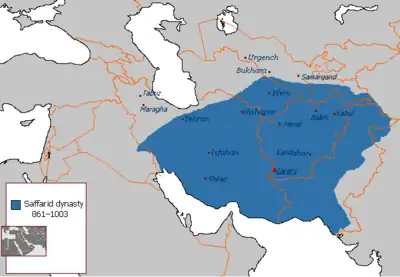 Saffarid dynasty at its greatest extent under Ya'qub ibn al-Layth al-Saffar | |||||||||||||||
| Capital | Zaranj | ||||||||||||||
| Common languages | Persian (administration, mother tongue)[1][2][3] | ||||||||||||||
| Government | Hereditary monarchy | ||||||||||||||
| Amir (Emir) | |||||||||||||||
• 861–879 | Ya'qub bin Laith as-Saffar | ||||||||||||||
• 963–1002 | Khalaf I | ||||||||||||||
| Historical era | Medieval | ||||||||||||||
• Established | 861 | ||||||||||||||
• Disestablished | 1003 | ||||||||||||||
| |||||||||||||||
The Saffarids used their capital Zaranj as a base for an aggressive expansion eastward and westward. They first invaded the areas south of the Hindu Kush, and then overthrew the Tahirid dynasty, annexing Khorasan in 873. By the time of Ya'qub's death, he had conquered the Kabul Valley, Sindh, Tocharistan, Makran (Balochistan), Kerman, Fars, Khorasan, and nearly reached Baghdad but then suffered a defeat by the Abbasids.[4]
The Saffarid dynasty did not last long after Ya'qub's death. His brother and successor, Amr bin Laith, was defeated at the Battle of Balkh against Ismail Samani in 900. Amr bin Laith was forced to surrender most of his territories to the new rulers. The Saffarids were confined to their heartland of Sistan, and with time, their role was reduced to that of vassals of the Samanids and their successors.
Founding
The dynasty began with Ya'qub ibn al-Layth al-Saffar (Ya'qub, son of Layth, the Coppersmith), a coppersmith of eastern Iranian origins,[lower-alpha 1][12] who moved to the city of Zaranj. He left work to become an Ayyar and eventually got the power to act as an independent ruler.[4] From his capital Zaranj he moved east into al-Rukhkhadj (Arachosia), Zamindawar and ultimately Kabul, vanquishing the Zunbils and the Hindu Shahis by 865. He then invaded Bamyan, Balkh, Badghis, and Ghor. In the name of Islam, he conquered these territories which were predominantly ruled by Buddhist tribal chiefs. He took vast amounts of plunder and slaves from this campaign.[14]
Expansion
The Tahirid city of Herat was captured in 870,[14] and Ya'qub's campaign in the Badghis region led to the capture of Kharidjites which later formed the Djash al-Shurat contingent in his army. Ya'qub then turned his focus to the west and began attacks on Khorasan, Khuzestan, Kerman (Southeastern Iran) and Fars (southwestern Iran).[14] The Saffarids then seized Khuzestan (southwestern Iran) and parts of southern Iraq, and in 876 came close to overthrowing the Abbasids, whose army was able to turn them back only within a few days' march from Baghdad. From silver mines in the Panjshir Valley, the Saffarids were able to mint silver coins.[16]
These incursions, however, forced the Abbasid caliphate to recognize Ya'qub as governor of Sistan, Fars and Kerman, and Saffarids were even offered key posts in Baghdad.[17] Despite Ya'qub's military successes, he was not an empire builder since he had no concept of a centralized government.[18]
Decline
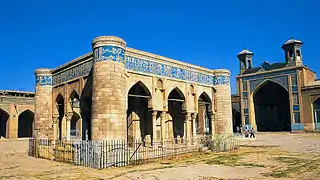
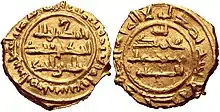
In 901, Amr Saffari was defeated at the battle of Balkh by the Samanids, and they lost Khorasan to them. The Saffarids were reduced to the provinces of Fars, Kerman and Sistan. Under Tahir ibn Muhammad ibn Amr (901–908), the dynasty fought the Abbasids for the possession of Fars to maintain its control over the province. However, in 908, a civil war erupted between Tahir and the pretender al-Laith b. 'Ali in Sistan. In the next years, the governor of Fars, Sebük-eri defected to the Abbasids. In 912, the Samanids finally expelled the Saffarids from Sistan. Sistan passed briefly to Abbasid control, but become independent again under the Saffarid Abu Ja'far Ahmad ibn Muhammad; but now the dynasty was a minor power isolated in Sistan.
In 1002, Mahmud of Ghazni invaded Sistan, dethroned Khalaf I and finally ended the Saffarid dynasty.[19]
Culture
The Saffarids patronized Persian language in the form of court poetry and established Persianate culture.[20] Under their rule, the eastern Islamic world witnessed the emergence of prominent Persian poets such as Fayrouz Mashriqi, Abu Salik al-Jirjani, and Muhammad ibn Wasif, who was a court poet.[21]
In the later 9th century, the Saffarids gave impetus to a renaissance of New Persian literature and culture. Following Ya'qub's conquest of Herat, some poets chose to celebrate his victory in Arabic, whereupon Ya'qub requested his secretary, Muhammad bin Wasif al-Sistani, to compose those verses in Persian.[22]
Religion
The religion of the Saffarid's founder, Ya'qub, has been a topic of debate.[23] Most of the primary sources were written during or after the fall of the Samanid dynasty and view the Saffarids through Samanid eyes.[lower-alpha 2] These primary sources depict Ya'qub either as a religious rascal or a volunteer Sunni warrior - a mutatawwi.[24] The Seljuk vizier Nizam al-Mulk, obsessed with the integrity of the Seljuk Empire, depicts Ya'qub as an Ismaili convert.[25]
According to C.E. Bosworth, early Saffarid emirs did not appear to have significant religious beliefs.[18] Since Kharijism prospered in Sistan longer than anywhere else in eastern Iran, it was believed the Saffarids held Kharijite sympathies.[26] Archeologist Barry Cunliffe, states the Saffarids were Shia Muslim.[27]
Rulers of the Saffarid dynasty
| Titular Name | Personal Name | Reign | |
|---|---|---|---|
| Independence from the Abbasid Caliphate. | |||
| Amir أمیر al-Saffar coppersmith الصفار |
Ya'qub ibn Layth یعقوب بن اللیث |
861–879 CE | |
| Amir أمیر |
Amr ibn al-Layth عمرو بن اللیث |
879–901 CE | |
| Amir أمیر Abul-Hasan أبو الحسن |
Tahir ibn Muhammad ibn Amr طاھر بن محمد بن عمرو co-ruler Ya'qub ibn Muhammad ibn Amr |
901–908 CE | |
| Amir أمیر |
al-Layth ibn 'Ali اللیث بن علي |
908–910 CE | |
| Amir أمیر |
Muhammad ibn 'Ali محمد بن علي |
910–911 CE | |
| Amir أمیر |
Al-Mu'addal ibn 'Ali المعضل ابن علي |
911 CE | |
| Amir أمیر Abu Hafs ابو حفص |
Amr ibn Ya'qub ibn Muhammad ibn Amr عمرو بن یعقوب بن محمد بن عمرو |
912–913 CE | |
| Samanid occupation 913–922 CE. | |||
| Amir أمیر Abu Ja'far ابو جعفر |
Ahmed ibn Muhammad ibn Khalaf ibn Layth ibn 'Ali | 922–963 CE | |
| Amir أمیر Wali-ud-Daulah ولي الدولة |
Khalaf ibn Ahmad ibn Muhammad ibn Khalaf ibn al-Layth ibn 'Ali | 963–1002 CE | |
| Conquered by Mahmud ibn Sebuktigin of the Ghaznavid Empire in 1002 CE. | |||
Gallery
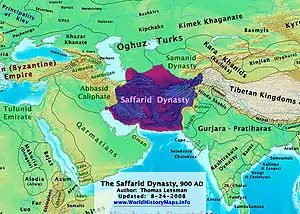 The Saffarid dynasty and its neighbors at its peak in 900 CE
The Saffarid dynasty and its neighbors at its peak in 900 CE Saffarid Soldier
Saffarid Soldier
See also
Notes
References
- "Persian Prose Literature". World Eras. HighBeam Research. 2002. Archived from the original on May 2, 2013. Retrieved September 3, 2012.
Princes, although they were often tutored in Arabic and religious subjects, frequently did not feel as comfortable with the Arabic language and preferred literature in Persian, which was either their mother tongue—as in the case of dynasties such as the Saffarids (861–1003), Samanids (873–1005), and Buyids (945–1055)...
- Robinson, Chase F. (2009). The new Cambridge history of Islam. Vol 1, Sixth to eleventh centuries (1. publ. ed.). Cambridge: Cambridge Univ. Press. p. 345. ISBN 978-0-521-83823-8.
The Tahirids had made scant use of Persian, though the Saffarids used it considerably more. But under the Samanids Persian emerged as a full "edged language of literature and (to a lesser extent) administration. Court patronage was extended to Persian poets, including the great Rudaki (d. c. 940). Meanwhile, Arabic continued to be used abundantly, for administration and for scientific, theological and philosophical discourse.
- Meisami 1999, p. 15.
- Bosworth, Clifford Edmund. "Saffarids". Encyclopædia Iranica.
- "Saffarid dynasty". The Oxford Dictionary of the Middle Ages. Oxford University Press. 2010. doi:10.1093/acref/9780198662624.001.0001. ISBN 9780198662624.
One of the first indigenous Persian dynasties to emerge after the Arab Islamic invasions.
- Savory, Roger M. (1996). "The History of the Saffarids of Sistan and the Maliks of Nimruz (247/861 to 949/1542–3)". Journal of the American Oriental Society. doi:10.2307/605756. JSTOR 605756.
First, the Saffarid amirs and maliks were rulers of Persian stock who for centuries championed the cause of the underdog against the might of the Abbasid caliphs.
- al Saffar, Ya'kub b. al-Layth; Bosworth, C. E. The Encyclopaedia of Islam. Vol. XI. p. 255.
The provincial Persian Ya'kub, on the other hand, rejoiced in his plebeian origins, denounced the Abbasids as usurpers, and regarded both the caliphs and such governors from aristocratic Arab families as the Tahirids with contempt
- Meisami, Julie Scott; Starkey, Paul (eds.). Encyclopedia of Arabic Literature. Vol. 2. p. 674.
Saffarids: A Persian dynasty.....
- Aldosari, Ali. Middle East, Western Asia, and Northern Africa. p. 472.
There were many local Persian dynasties, including the Tahirids, the Saffarids....
- Cannon, Garland Hampton. The Arabic Contributions to the English Language: An Historical Dictionary. p. 288.
Saffarid, the Coppersmith, the epithet of the founder of this Persian dynasty...
- Daftary, Farhad. Historical Dictionary of the Ismailis. p. 51.
The Saffarids, the first Persian dynasty, to challenge the Abbasids...
- Baumer 2016, p. 24.
- Bosworth 1995, p. 795.
- Flood, Finbarr B. (20 March 2018). Objects of Translation: Material Culture and Medieval "Hindu-Muslim" Encounter. Princeton University Press. pp. 25–26. ISBN 978-0-691-18074-8.
- Bosworth et al. 1995, p. 258.
- Esposito, John L. (1999). The Oxford History of Islam. Oxford: Oxford University Press. p. 38.
- Meisami 1999, p. 120.
- Bosworth, C. E. (1963). The Ghaznavids 994–1040. Edinburgh University Press. p. 89.
- Dabashi 2019, p. 41.
- Bosworth 1969, p. 104.
- Bosworth, C. E. (1999). "The Tahirids and the Saffarids". In Frye, R. N. (ed.). The Cambridge History of Iran: The period from the Arab Invasion to the Saljuqs. Vol. IV. Cambridge University Press. p. 129.
- Tor 2007, p. 85-87.
- Tor 2007, p. 90.
- Bosworth 1975, p. 108.
- Bosworth 1975, p. 107.
- Cunliffe 2015, p. 388-389.
Sources
- Baumer, Christoph (2016). The History of Central Asia: The Age of Islam and the Mongols. Vol. Three. I.B. Tauris. p. 24. ISBN 978-1-78453-490-5.
- Bosworth, C. E. (1969). "The Ṭāhirids and Persian Literature". Iran. 7: 104. doi:10.2307/4299615. JSTOR 4299615.
- Bosworth, C.E. (1975). "The Ṭāhirids and Șaffārids". In Frye, R.N. (ed.). The Cambridge History of Iran. Vol. 4:The Period from the Arab invasion to the Saljuqs. Cambridge University Press. pp. 90–135.
- Bosworth, C. E. (1995). "Saffarids". In Bosworth, C. E.; van Donzel, E.; Heinrichs, W. P.; Lecomte, G. (eds.). Encyclopedia of Islam. Vol. VIII:NED-SAM. Brill. pp. 795–798.
- Cunliffe, Barry W. (2015). By Steppe, Desert, and Ocean: The Birth of Eurasia. Oxford University Press. pp. 388–389. ISBN 9780199689170.
The Sunni Samanids eventually annexed the territories of the Shi'ite Saffarids in 908, creating a powerful emirate bounded by the Pamir, the Caspian Sea, the Iranian plateau, and the steppe.
- Dabashi, Hamid (2019). The Shahnameh: The Persian Epic in World Literature. Columbia University Press. ISBN 978-0231544948.
- Meisami, Julie Scott (1999). Persian Historiography to the End of the Twelfth Century. Edinburgh University Press. ISBN 978-0748612765.
- Tor, D.G. (2007). Violent Order: Religious Warfare, Chivalry, and the ʻAyyār Phenomenon in the Medieval Islamic World. Orient-Institut-Istanbul.
- Bosworth, C. E.; van Donzel, E.; Heinrichs, W. P.; Lecomte, G., eds. (1995). "Pandjhir". The Encyclopaedia of Islam. Vol. VIII:NED-SAM. Brill. p. 258.
| History of Iran |
|---|
 |
|
Timeline |
| History of Afghanistan |
|---|
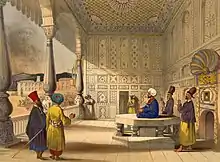 |
| Timeline |
|
_on_the_obverse._Nagari_%22Sri_Kudarayaka%22_on_the_reverse_(%E2%80%9CKhudarayaka%E2%80%9D)_Circa_895-921_CE.jpg.webp)